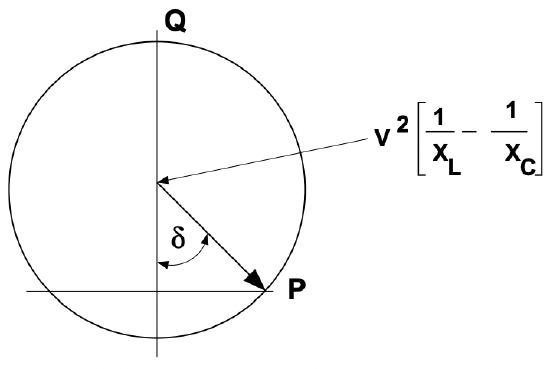2.10: Compensated Line
- Page ID
- 55541
 Figure 20: Transmission Line Model
Figure 20: Transmission Line ModelPerhaps a more commonly used model for a transmission line is as shown in Figure 20. This represents not only the fact that most transmission lines have, in addition to series inductance, parallel capacitance but also the fact that many transmission lines are shunt compensated. This may be represented as a two-port network with the admittance parameters, using \(\ X_{L}=j \omega L\) and \(\ X_{C}=\frac{-j}{\omega C}\),:
\(\ \begin{array}{l}
\underline{Y}_{s s} \quad=\quad \frac{1}{j X_{L}}-\frac{1}{j X_{C 1}} \\
\underline{Y}_{s r}=\underline{Y}_{r s}=\frac{1}{j X_{L}} \\
\underline{Y}_{r r} \quad=\quad \frac{1}{j X_{L}}-\frac{1}{j X_{C 2}}
\end{array}\)
It is fairly clear that, for voltage sources at both ends, real and reactive power flow are:
\(\ \begin{aligned}
P_s&=\frac{V_sV_r\sin{\delta}}{X_L}\\
Q_{s} &=V_{s}^{2}\left(\frac{1}{X_{L}}-\frac{1}{X_{C 1}}\right)-\frac{V_{s} V_{r} \cos \delta}{X_{L}} \\
P_{r} &=-\frac{V_{s} V_{r} \sin \delta}{X_{L}} \\
Q_{r} &=V_{s}^{2}\left(\frac{1}{X_{L}}-\frac{1}{X_{C 2}}\right)-\frac{V_{s} V_{r} \cos \delta}{X_{L}}
\end{aligned}\)
 Figure 21: Power Circle, Equal Voltages, Compensation Offset
Figure 21: Power Circle, Equal Voltages, Compensation OffsetThe power circle for this sort of line is similar to that of the simpler model, but the center is offset to smaller reactive component, as shown in Figure 21.
An interesting feature of transmission lines is illustrated by what might happen were the receiving line to be open: in that case:
\(\ \underline{V}_{r}=\underline{V}_{s} \frac{1}{1-\omega^{2} L C}\)
Depending on the values of frequency, inductance and capacitance this could be arbitrarily large, and this is a potential problem, particularly for longer lines, as we will discuss in the next section.


